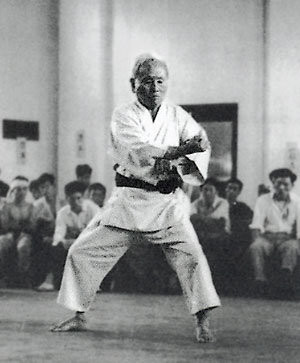Follow your Dreams
“Be soft in your practice. Think of the method as a fine silvery stream, not a raging waterfall. Follow the stream in its course. It will go its own way, meandering here, trickling there. It will find the grooves, the cracks, the crevices. Just follow it. Never let it out of your sight. It will take you.”
History of karate
History of Karate
The art originated on the island of Okinawa and in its early form was heavily influenced by ancient Chinese martial arts, collectively known as kung fu.
The Beginnings of Karate History on Okinawa
The history of Okinawan Karate can be traced back to the late 17th century when a ban on weapons was imposed by the samurai rulers of Japan.The exact evolution of karate history is lost due to the lack of information being written down which is unsurprising when taking into account the strict rules against subjects of the island learning martial arts.
This meant that all training by early masters such as Kanga Tode Sakugawa (pictured) and Sokon 'Bushi' Matsumura, had to be done in secret and as weapons could not be carried on the island, self-defence tended to revolve around empty handed techniques.
The earliest surviving written evidence of karate in Okinawa was a mention of the word Tode (the Okinawan name for the art) in the late 1700s. It was in reference to a visitor to the island from China named Kushanku who taught a form of Kung Fu and may have introduced the first version of the Shotokan kata kanku dai. Tode style blended with the martial arts already being cultivated on the island which was known as Te, meaning ‘hand’.
Te was popular in three cities in particular, Shuri, Naha and Tamarai. Each city had its own way of doing the martial arts and modern day styles reflect this; Shotokan and Shito-ryu are mostly influenced by the style from the city of Shuri, that is Shuri-te, and to a lesser extent Tamarai-te. Goju-ryu on the other hand is more influenced by Naha-te.
Karate History and its Development into a World Martial Art
At the turn of the 20th century, Anko Itosu gained permission to end the shroud of secrecy for those who wanted to learn martial arts and began teaching Te in Okinawan schools. This led to further expansion by one of Itosu’s students, Sensei Gichin Funakoshi, who introduced the art to Japan in 1922.Funakoshi made many modifications to the art to make it more accessible to the Japanese including changing the name and karate as we know it today was born. Towards the end of his life, Funakoshi was instrumental in forming the Japanese Karate Association (JKA) which set about making karate a world martial art by sending out its best instructors to teach it all over the globe.
Today, karate is practiced by millions of people right across the world and although the lines are often blurred between karate history facts and exagerations or legends, the contribution made by the old Okinawan masters and those that followed them should not be forgotten.
About karate
What is karate?
Karate is a Japanese martial art whose physical aspects seek the development of defensive and counterattacking body movements. The themes of traditional karate training are fighting and self-defense, though its mental and moral aspects target the overall improvement of the individual. This is facilitated by the discipline and persistent effort required in training. If karate had to be described in only one sentence, then the most suitable one may arguably be "You never attack first in karate." This is a a maxim of Gichin Funakoshi (1868-1957), the Okinawan who brought karate to Japan in 1922, and who is accepted as the father of modern karate.
The word karate is a combination of two kanji (Chinese characters): kara, meaning empty, and te, meaning hand; thus, karate means "empty hand." Adding the suffix "-dō" (pronounced "daw"), meaning "the way/path," karate-dō, implies karate as a total way of life that goes well beyond the self-defense applications. In traditional karate-dō, one is supposed to compete and strive to excel against him/herself.
Today there are four main styles of karate in Japan: Shotokan, Goju-ryu, Shito-ryu, and Wado-ryu. Shotokan, though never described as a style by Gichin Funakoshi, it has been nevertheless considered as his. Actually Shotokan was the name of his dōjo, chosen after the pen name used by Funakoshi to sign poems written in his youth. Shotokan Karate is characterized by powerful linear techniques and deep strong stances. It is the style taught at the Tulane Karate Club.
Like the word karate, Shotokan is also composed of two different kanji : Shoto, meaning "pine breeze" and kan, meaning "the place", thus Shotokan means the place of shoto.
Yet Funakoshi is one of the most honored, cherished and memorable martial artists in history. His innovations left indelible marks on the art form we know today as karate. Not only was shotokan karate, the style he founded, influenced by Funakoshi, but dozens of other styles as well.
Subscribe to:
Comments (Atom)






